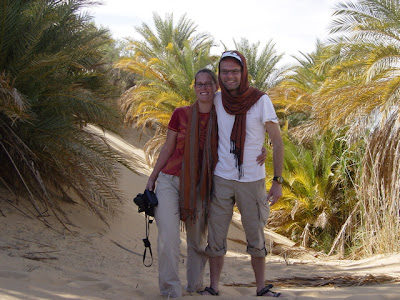We rented a small (on the US scale, i.e. pretty big) camper van for our trek.
 We started in Jackson Hole and drove via Grand Teton National Park to Flagg Range campsite. On our way we saw our first bear crossing the road. We were not really prepared as our cameras was still packed deeply in our luggage. It turned out that this was the only bear we saw this holiday: so, unlike us, always have your camera ready!
We started in Jackson Hole and drove via Grand Teton National Park to Flagg Range campsite. On our way we saw our first bear crossing the road. We were not really prepared as our cameras was still packed deeply in our luggage. It turned out that this was the only bear we saw this holiday: so, unlike us, always have your camera ready!From our first camp we drove north to the southern entrance of Yellowstone.
 We started to explore the Upper, Lower and Midway Geyser basins from our first "base camp" at the Grand village campsite. We made many day trips with our mobile home, and Luka felt at home quickly.
We started to explore the Upper, Lower and Midway Geyser basins from our first "base camp" at the Grand village campsite. We made many day trips with our mobile home, and Luka felt at home quickly.
Lower Geyser Basin

Apart from geysers we saw beautiful blue-coloured hot springs such as Silex Spring.
 At the fountain paint pots in the Lower Geyser Basin you can see hot mud bubbling up.
At the fountain paint pots in the Lower Geyser Basin you can see hot mud bubbling up.
This vat of bubbling mud contains the perfect mix of ingredients to create mud pots: heat, gases, water, volcanic rock, minerals, acid, and even living organisms! Heat loving thermopiles consume some of the gases and help convert them into sulfuric acid. The acid breaks down rock to form clay; clay that mixes with water in mud pots.
Midway Geyser Basin
One of the more spectacular sights in the Midway Geyser basin was Excelsior Geyser.

In the 1880s Excelsior Geyser erupted in bursts 15-100 meters high. The thermal violence formed the jagged crater and apparently ruptured the geyser’s underground system, causing eruptions to cease after 1880.
Though eruptions have been erratic the geyser’s outflow is nearly constant, pumping more than 15,000 litres of boiling water per minute over the carter rim into the Firehole River.
But the most impressive sight of the Midway Geyser basin was Grand Prismatic Spring.

Deep beneath us, magma from an active volcano heats water that rises to the surface through fissures in the rock. The result is a hot spring that pours almost 2,000 litres of hot water each minute into the Firehole River. Minerals dissolved in the hot water are deposited and gradually build the gracefully terraced shoulders of this feature.

The yellow, orange, and brown colors encircling the hot spring and lining the runoff channels are caused by thermophiles – heat-loving microorganisms. These microbes contain colorful pigments that allow them to make energy from sunlight and thrive in the harsh conditions of hot springs.
Upper Geyser Basin
Across the Firehole River is Riverside Geyser, one of he most predictable and consistent geysers in Yellowstone with eruptions taking place every 5.5 to 7.5 hours. Beginning an hour or two before an eruption, water pour over the cone’s edge, and splashing and bubbling become more visible. Then, water and steam arch over the river to heights of 225 meters. The eruption will last about 22 minutes.


Further north in the Hayden valley we saw a spectacular herd of bison creating traffic jams when crossing the road, giving us plenty of time for photos!

Canyon
Near our campsite at Canyon Village, the Yellowstone River cuts a deep canyon into the ryolite rock. The canyon starts with the spectacular Upper and Lower Falls. The Lower Falls with the colourful surrounding rock make beautiful scenery.
 Via a steep footpath you can climb down to the brink of the lower falls and see the water roar down into the canyon.
Via a steep footpath you can climb down to the brink of the lower falls and see the water roar down into the canyon.

Mammoth Hot Springs
From our "base camp" at Canyon Village we explored Mammoth Hot Spring in the North. We first walked up to the main terrace, where Canary Spring resides.

Hot Spring waters of Canary Spring cascade down from the terrace forming colourfull terraces of travertine.

Shimmering at Pallete Spring is a living palette of colour. Billions of heat-loving microorganisms called thermophiles carpet the spring.

As you look at the spring’s patchwork of colors, you are looking at a world of thermophiles. Many species flourish here, each in a unique niche created by subtle differences in the spring. Temperatures vary – spots too hot or too cool for some are perfect for other thermophiles. Gases, most potent at the vent, are nutritious for some, but deadly for others. Swirling water or calm pools create different living conditions. The formations’ miniature hills and valleys capture light and cast shadows – habitats, for sun or shade loving thermophiles.
On our day trip there we could not resist to drive to the northern boundary of Yellowstone crossing the 45th parallel and the Wyoming to Montana state boundary.

Norris Geyser Basin
The last day trip before heading south back to the airport at Jackson Hole, was west to the Norris Geyser Basin consisting of the Back Basin and the Porcelain Basin.

In this raw, acidic land full of iron and arsenic, thermophiles and extremophiles (microorganisms that live in heat and other extremes) inhabit geysers and hot springs.

Many pools are opalescent or cloudy. Murky waters are caused by silica in the water. Colloidal Pool is a perfect example.

Our trek ended where it started, back at Jackson Hole. We had a great time!






No comments:
Post a Comment